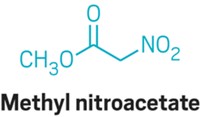Advertisement
Grab your lab coat. Let's get started
Welcome!
Welcome!
Create an account below to get 6 C&EN articles per month, receive newsletters and more - all free.
It seems this is your first time logging in online. Please enter the following information to continue.
As an ACS member you automatically get access to this site. All we need is few more details to create your reading experience.
Not you? Sign in with a different account.
Not you? Sign in with a different account.
ERROR 1
ERROR 1
ERROR 2
ERROR 2
ERROR 2
ERROR 2
ERROR 2
Password and Confirm password must match.
If you have an ACS member number, please enter it here so we can link this account to your membership. (optional)
ERROR 2
ACS values your privacy. By submitting your information, you are gaining access to C&EN and subscribing to our weekly newsletter. We use the information you provide to make your reading experience better, and we will never sell your data to third party members.
Safety
Sodium Azide Precautions
April 5, 2010
| A version of this story appeared in
Volume 88, Issue 14
Two recent articles refer to the hazards of working with sodium azide (NaN3) (C&EN, Jan. 11, page 4, and Nov. 9, 2009, page 8). American Azide Corp., a division of American Pacific Corp. (AMPAC), has safely produced more than 9 million kg of sodium azide over the past 17 years. The azide ion is an extremely useful nucleophile that has been used safely for many years at companies such as AMPAC Fine Chemicals (AFC, formerly Aerojet Fine Chemicals). AFC has used this reagent on a commercial scale for more than 50 years in the production of intermediates for the pharmaceutical and defense industries. Sodium azide is the reagent of choice for the production of primary amines, isocyanates, and several heterocyclic compounds and is widely used in the synthesis of a number of pharmaceuticals, including Avapro, Diovan, and Tamiflu.
As with many chemicals deemed hazardous, sodium azide can be safely handled and used in large-scale chemical processes as long as certain precautions are taken (see, for example, Chemical Market Reporter, Jan. 3, 2005, page 267). Incompatibility of sodium azide with certain heavy metals is well-known. However, the reactivity of NaN3 with acids to form hydrazoic acid is not well publicized.
The formation of hydrazoic acid, and in particular condensation of neat hydrazoic acid, must be avoided under all possible conditions. As chemists and engineers, we should understand the true hazards of the chemical involved and then put controls in place to handle it safely. Finally, we should be vigilant in our education of chemists regarding the safe handling of these compounds, whether in university, industrial, or government laboratories.
Kent Richman
Vice President, Research & Product Development, American Pacific Corp.
Las Vegas





Join the conversation
Contact the reporter
Submit a Letter to the Editor for publication
Engage with us on Twitter